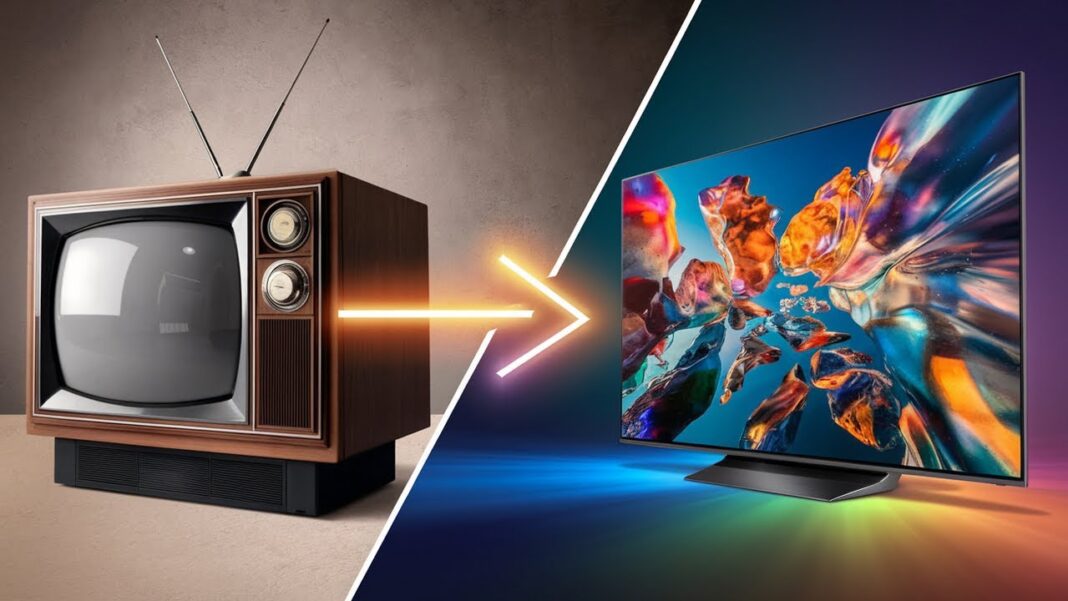The Innovation of television has spanned over a century, marked by incredible advancements in technology, quality, and user experience. Here’s a step-by-step journey through the key milestones in the development of television, from its early beginnings to the latest advancements in smart TVs. Television Innovation Step by Step 1st to Latest
1. Inception of Television (1920s-1930s)
Television began in the 1920s with mechanical systems. In 1927, Philo Farnsworth, an American inventor, developed the first fully electronic television system, which used an “image dissector” to capture images. British engineer John Logie Baird demonstrated the first successful transmission of moving images in 1925 using a mechanical television. By the late 1930s, electronic television systems became more advanced, and several companies started producing TVs with electronic scanning for public use.
2. Public Broadcasts and Standardization (1930s-1940s)
Television broadcasts began in the late 1930s, notably with the BBC in the United Kingdom and NBC in the United States, providing the first scheduled programming. World War II briefly halted TV development, but after the war, television sets started appearing in more homes. By the late 1940s, television became a household item in North America and Europe, leading to the establishment of broadcast standards, including the National Television System Committee (NTSC) standard in the United States.
3. The Rise of Black-and-White TV (1950s)
In the 1950s, television became a cultural phenomenon. By this time, black-and-white TVs had become widely accessible, and shows like I Love Lucy and The Ed Sullivan Show became instant classics. During this period, networks established themselves, and the “golden age of television” was characterized by high-quality dramas, variety shows, and news broadcasts.
4. Color TV Emerges (1960s)
Color TV technology emerged in the 1960s, with RCA introducing the first commercially viable color television in 1954. However, it wasn’t until the mid-1960s that color broadcasts gained traction. The FCC officially authorized the NTSC color system in the U.S. in 1953, leading networks to adopt it. By the late 1960s, most prime-time programming in the United States was broadcast in color, transforming the viewer experience.
5. Remote Controls and Cable TV (1970s)
The 1970s brought remote controls, making TV viewing more convenient. Cable television also emerged, providing more channel variety. HBO launched in 1972 as one of the first pay-TV networks, allowing audiences to view premium content. This shift set the stage for more specialized programming and laid the groundwork for today’s subscription-based model.
6. VCRs and Home Entertainment (1980s)
The 1980s introduced the Video Cassette Recorder (VCR), enabling viewers to record shows and watch movies at home. Companies like Sony and Panasonic popularized VCR technology, making TV programming more flexible for audiences. Cable networks such as MTV and CNN expanded their reach, creating dedicated channels for music and 24-hour news. This era marked the expansion of television from broadcast-only to include cable and recorded content.
7. High-Definition Television (HDTV) and Digital TV (1990s-2000s)
In the 1990s, high-definition television (HDTV) was developed, offering sharper images and superior sound quality. Japan was the first country to broadcast in HD in 1989, followed by Europe and the United States in the late 1990s. The shift from analog to digital broadcasts in the early 2000s allowed for improved picture quality, and in 2009, the U.S. switched off analog signals entirely. Digital television also introduced new capabilities, including better sound, more channels, and multimedia services.
8. The Flat-Screen Revolution (2000s)
In the early 2000s, flat-screen technologies like LCD (Liquid Crystal Display) and plasma screens replaced bulky CRT (cathode ray tube) televisions. These TVs were thinner, lighter, and could be mounted on walls, drastically changing home aesthetics. LCD quickly became the standard for high-definition screens due to its lower power consumption and longer lifespan compared to plasma. By the late 2000s, LED backlighting made screens even slimmer and more energy-efficient.
9. Smart TVs and Internet Integration (2010s)
Smart TVs emerged in the 2010s, combining traditional television with internet connectivity. With built-in Wi-Fi, smart TVs allowed users to stream content from platforms like Netflix, YouTube, and Hulu without additional hardware. This innovation effectively merged television with digital streaming, allowing users to browse the web, play games, and even control their smart home devices from their TV screens. Brands like Samsung, Sony, and LG became pioneers in this segment, emphasizing app ecosystems and user-friendly interfaces.
10. 4K Ultra HD and HDR (Mid-2010s)
Ultra High Definition (4K) TVs entered the market around 2014, offering four times the resolution of HD. With greater detail, enhanced colors, and larger screens, 4K TVs rapidly gained popularity as content became available. High Dynamic Range (HDR) technology also emerged, enhancing brightness, contrast, and color depth, which led to a more immersive viewing experience.
11. OLED and QLED Technologies (2010s-Present)
OLED (Organic Light-Emitting Diode) TVs emerged, offering deeper blacks, better contrast, and wider viewing angles compared to LCDs. OLED technology, pioneered by LG, became popular among high-end televisions. Samsung introduced QLED (Quantum Dot LED) technology, which uses quantum dots to enhance color accuracy and brightness. The competition between OLED and QLED TVs dominated the premium market and continues to advance picture quality.
12. 8K Resolution and Beyond (Late 2010s-Present)
The next step in resolution, 8K, arrived in the late 2010s. With four times the pixels of 4K, 8K TVs offer incredibly detailed images. Although limited 8K content is currently available, manufacturers are positioning 8K as the next frontier in television technology. Companies like Samsung, LG, and Sony have introduced 8K models, though adoption remains limited due to high costs and minimal content.
13. AI and Voice-Controlled TVs (2020s)
The latest smart TVs now include Artificial Intelligence (AI) for enhanced picture and sound quality. AI algorithms optimize settings based on the content type and room lighting. Voice-controlled assistants like Amazon’s Alexa, Google Assistant, and Samsung’s Bixby allow users to control their TVs and connected smart devices hands-free, integrating TV sets with the broader smart home ecosystem.
14. MicroLED and Rollable TVs (Present and Future)
MicroLED technology, similar to OLED but without organic materials, offers even better brightness and longevity. Companies like Samsung are pioneering MicroLED for its ability to create modular, custom-sized screens. LG also introduced rollable TVs, a revolutionary design that allows the screen to roll up when not in use, changing how we think about television aesthetics and functionality.
Conclusion
Television has come a long way from black-and-white images to smart, interactive devices that respond to voice commands and offer cinema-quality experiences at home. Each stage of TV’s evolution has pushed the boundaries of visual technology and transformed how we consume media. As technology continues to advance, the future of television holds exciting possibilities for even more immersive and interactive viewing experiences.






